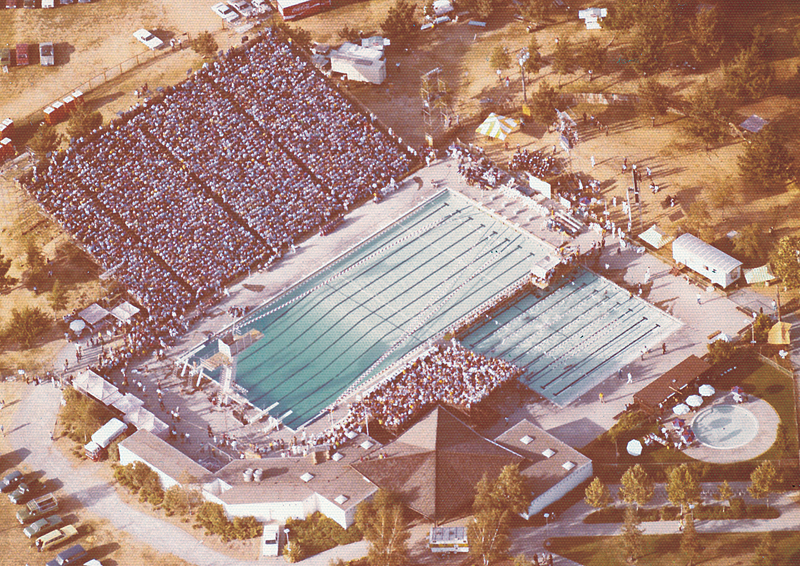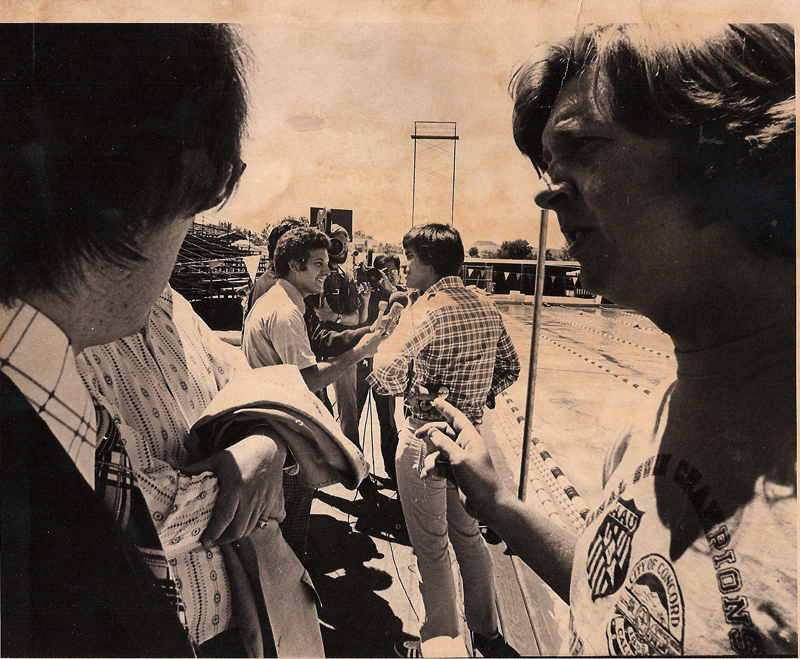In 1974 Concord Community Pool hosted the Six Greatest Days of Swimming


CONCORD, CA (August 22, 2024) — Fifty years ago this month—decades before 2024 Olympic legends Katie Ledecky and Leon Marchand were born—it was Concord that “captured the hearts of the swimming world.”
Swimming World, the bible of aquatic sports, went on to say of Concord in a front-page editorial in the October 1974 issue, “You made this a meet that will be long remembered….it was one for the books. It was six days of swimming never equaled in the United States.”
From Aug. 22 to Sept. 1, 1974, Concord Community Pool hosted six days of swimming that was unprecedented outside of an Olympics. The annual United States AAU National Long Course Championships were Aug. 22-25 followed by the United States vs. German Democratic Republic dual meet on Aug. 31 and Sept. 1. World records were set each of the six days.
Over those six days in Concord there were 25 world records and 47 American records tied or broken as the two meets drew world-wide media attention. American, Canadian, Australian, Commonwealth, Brazilian, European and GDR (East Germany) records were smashed one after another, bringing thrills to the over 35,000 spectators that filled the temporary bleachers at the pool.
World records were set each of the six days. By contrast the just concluded Paris Olympic swimming competition featuring all the top swimmers from around the world saw only four world records set!
New pool

Concord Community Pool opened as part of a community park on Cowell Road in 1967 with its unique L-shaped 50-meter and 25-yard pool.
A few years later, Concord swim dad (and mayor/councilman) Dan Boatwright led a delegation to Lake Placid, NY that included Concord Leisure Services Director John Toffoli Jr., Concord Swim Club founder and Hall of Fame coach Pete Cutino and city officials supported by City Manager F. A. Bud Stewart to bid on hosting the national championships in their new pool.
The bid effort was successful, and Concord was awarded the 1973 Summer Nationals. Louisville later reached out to the AAU (Amateur Athletic Union which was the sanctioning body for all American amateur sports at that time) requesting they have that meet.
Dual Meet arrives as bonus

National swimming officials approached Concord and as a sweetener to moving their meet ahead to 1974, the AAU said the city could also host the highly anticipated USA-GDR dual meet.
Preparations for the meet were already underway and over the period before the meets Concord hosted site visits by USA national and GDR officials to inspect the pool and other facilities. Concord officials were present at the 1974 AAU Short Course Nationals that spring in Dallas to promote the upcoming meets and observe site logistics.
Retired swimming legend Mark Spitz, fresh off his 1972 “seven races, seven world records, seven gold medals” performance two years earlier at the Munich Olympics, came to the pool to promote the meets in advance.
To make their L-shaped pool into a traditional rectangular 50-meter, 8-lane pool Concord installed a bulkhead along the 25-yard opening at the “bottom of the L.” Temporary bleachers were installed on two sides of the pool to accommodate 6,000 spectators a day.
A week or so before the meet, Toffoli, concerned about the water temperature being exactly as requested by swim officials, dispatched his long-time aquatics director Pete Chalmers to maintain near 24-hour monitoring of the pool water.
When swimmers from around the world arrived for the AAU meet, how “fast” of a pool Concord Community would be was anyone’s guess.
Record settles fears
All those fears vanished in the Thursday morning men’s 400-meter freestyle preliminaries when Long Beach 16-year-old Tim Shaw shattered the world record. You could almost hear the sigh of relief from Concord and AAU officials over the cheers of the crowd. Shaw went on to also star for the American team the following weekend.
One of the benefits of winning an AAU championship that year for American swimmers was the chance to be chosen for the dual meet team the following weekend. USA head coach Flip Darr and his assistants assembled a team to compete against the powerful East Germans.
The international print and television media on hand were touting the dual meet as “the most dramatic sports event between two countries since 1962 when the United States and Soviet Union met at Stanford in track and field.” They called it “the greatest international sports event ever.” All six days received world-wide coverage and TV broadcasts not only in the US but Europe and Australia.
Although there were plenty of rumors after GDR performances at the 1972 Munich Olympics and 1973 World Championships in Belgrade, it would not be until the Berlin Wall fell a year after the 1988 Seoul Olympics that proof of the state-sponsored doping system of GDR athletes was uncovered.
The Germans with their near invincible women’s team came to California hopeful of defeating long-time powerhouse USA. With capacity crowds looking on, the American men won every event and the Yank swimmers won the meet 198-145. In a separately scored diving meet for men and women on Concord’s 10-meter platform and 3-meter springboard the Americans prevailed 24-20.
Hall of Fame
Nothing that weekend topped Saturday’s 200-meter backstroke race. Two-time Olympic champion Roland Matthes, 23, had not lost a race in seven years when he faced off with 18-year-old John Naber. The California teen not only beat Matthes in the 200 but the next day Naber prevailed in the 100 and in the leadoff leg of the medley relay.
To date, nine swimmers and two divers who competed in Concord 50 years ago have been inducted into the International Swimming Hall of Fame. From the DGR team are Ulrike Richter, Matthes, Kornelia Ender and Falk Hoffman. American inductees are Phil Boggs, Joe Bottom, Mike Bruner, Bruce Furniss, Tim Shaw, Naber and John Hencken.
Concord Community Pool not only hosted those two historic meets but over the years it was the training pool for Olympians Natalie Coughlin, Peter Rocca, Matt Biondi and Nancy Hogshead, who combined for 15 gold, 9 silver and 6 bronze Olympic medals.
Swimming World labeled a two-page photo collage from Concord in its October 1974 issue the “Six Greatest Days of Swimming.”
Jay Bedecarré served as meet publicist for the two swim meets and is one of the very few surviving officials from those 1974 meets.

Jay Bedecarré
Jay Bedecarré is a long-time resident and writer in Concord and Clayton. He began his newspaper writing career while still a senior at Mt. Diablo High School and he has been part of The Pioneer since its inception in 2003. Jay also operates Bay Area Festivals, presenting events around the San Francisco Bay Area including Bay Area KidFest annually in Downtown Concord.















